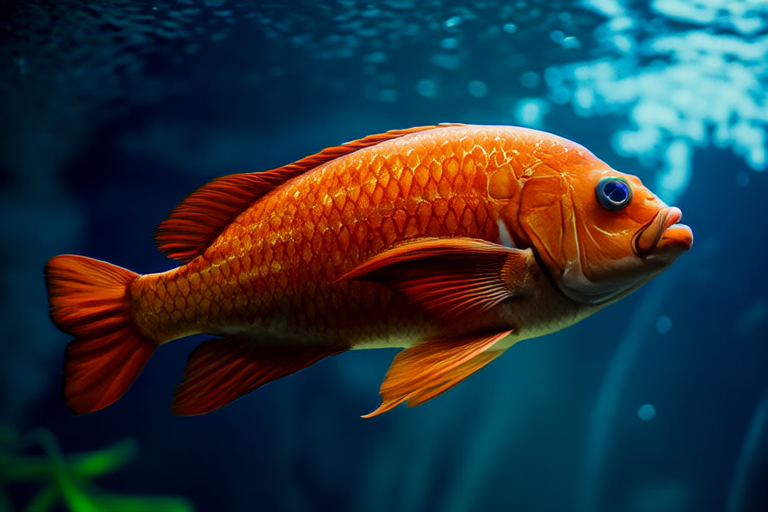Discover the Majestic Rajah Cichlid: Your Ultimate Care Guide
Introduction to the Rajah Cichlid
The Rajah Cichlid, scientifically known as Parachromis dovii, is a stunning freshwater fish that captivates aquarists with its vibrant colors and dynamic personality. Native to Central America, particularly regions like Nicaragua and Costa Rica, this species thrives in warm, slow-moving waters such as rivers and lakes. Known for its striking golden hues, intricate patterns, and bold demeanor, the Rajah Cichlid stands out as a centerpiece in any aquarium.
What makes the Rajah Cichlid so appealing is not just its beauty but also its intelligence and active behavior. Watching this fish explore its environment, interact with tank mates, or even recognize its owner is a rewarding experience. However, its care requires dedication and understanding, making it an ideal choice for both intermediate and advanced hobbyists who are ready to meet its needs.
Detailed Care Requirements
Tank Size
One of the most critical aspects of Rajah Cichlid care is providing ample space. These fish can grow up to 18-20 inches in length, so a minimum tank size of 125 gallons is recommended for a single specimen. If you plan to keep them with tank mates, a larger tank of at least 180 gallons is necessary to prevent territorial disputes and ensure everyone has enough room to thrive.
Water Parameters
Rajah Cichlids are hardy but still require specific water conditions to stay healthy:
- Temperature: Maintain a range of 75-82°F (24-28°C).
- pH Level: Aim for slightly acidic to neutral water, between 6.5 and 7.5.
- Hardness: Keep water hardness between 5-15 dGH.
Regular water changes (20-30% weekly) are essential to maintain pristine conditions and reduce waste buildup.
Filtration and Tank Setup
A powerful filtration system is crucial for managing the bioload of these large, active fish. Canister filters or sumps are excellent choices as they provide mechanical, chemical, and biological filtration. Additionally, consider adding an air stone or powerhead to enhance oxygenation.
For the tank setup, use a fine sand substrate to mimic their natural habitat. Include sturdy rocks, driftwood, and caves to create hiding spots and territories. Live plants can be added, but choose robust species like Anubias or Java Fern, as Rajah Cichlids may uproot delicate ones.
Dietary Needs
Rajah Cichlids are omnivorous predators with hearty appetites. In the wild, they feed on smaller fish, insects, and crustaceans. In captivity, their diet should consist of high-quality protein sources:
- Pellets or flakes designed for cichlids
- Frozen or live foods like brine shrimp, bloodworms, and earthworms
- Occasional treats of chopped seafood (shrimp, squid)
Feed your Rajah Cichlid 2-3 times daily, offering only what they can consume within 2-3 minutes. Overfeeding can lead to obesity and poor water quality. Supplementing their diet with vegetables like zucchini or spinach once a week ensures balanced nutrition.
Temperament and Compatibility
Rajah Cichlids are known for their assertive and sometimes aggressive nature. They are highly territorial, especially during breeding season, and may chase or bully other fish. Despite this, they can coexist peacefully with compatible tank mates if given enough space and proper tank setup.
Suitable companions include other large, semi-aggressive fish like Oscars, Jack Dempseys, or Green Terrors. Avoid small, timid species, as they may become targets. To manage aggression, rearrange decorations occasionally to disrupt established territories and reduce dominance behaviors.
Breeding
Breeding Rajah Cichlids can be a fascinating yet challenging endeavor. These fish form monogamous pairs and exhibit strong parental instincts. Here’s how to encourage breeding:
- Provide a spacious tank with plenty of flat surfaces (like rocks or slate) for egg-laying.
- Increase the temperature slightly to around 80°F (27°C).
- Offer nutrient-rich foods to condition the pair.
Once spawning occurs, the female will lay hundreds of eggs, which both parents will guard fiercely. The fry typically hatch within 3-5 days and become free-swimming shortly after. Feed them baby brine shrimp or finely crushed flakes until they grow large enough to eat regular food.
Common challenges include aggression towards tank mates during breeding and ensuring adequate nutrition for the fry. Isolating the breeding pair in a separate tank can help mitigate these issues.
Common Health Issues and Prevention Tips
Like all fish, Rajah Cichlids are susceptible to certain health problems. Common ailments include:
- Hole-in-the-head disease: Often caused by poor water quality or nutritional deficiencies. Prevent it by maintaining clean water and feeding a varied diet.
- Ich: Characterized by white spots on the body. Treat with gradual temperature increases and over-the-counter medications.
- Bacterial infections: Look for signs like lethargy or red streaks. Quarantine affected fish and treat with antibiotics if necessary.
Preventative measures include regular water testing, avoiding overcrowding, and quarantining new fish before introducing them to the main tank.
Tips for Beginners and Advanced Aquarists
Whether you’re new to the hobby or a seasoned aquarist, here are some tips to ensure long-term success with Rajah Cichlids:
- Research thoroughly: Understand their needs before committing to ownership.
- Invest in quality equipment: A reliable heater, filter, and test kits are non-negotiable.
- Observe regularly: Spend time watching your fish to detect early signs of stress or illness.
- Be patient: Building a harmonious tank takes time, especially when dealing with territorial species.
For beginners, start with a smaller, less aggressive cichlid species to gain experience before tackling the Rajah Cichlid. Advanced aquarists can experiment with creative tank setups and breeding projects to deepen their connection with these magnificent fish.
Conclusion
The Rajah Cichlid is a true gem of the aquarium world, combining beauty, intelligence, and charisma in one impressive package. While caring for this species requires effort and commitment, the rewards are well worth it. By providing the right environment, diet, and companionship, you can enjoy the majesty of the Rajah Cichlid while fostering a thriving aquatic ecosystem. Whether you’re a beginner eager to learn or an expert seeking a new challenge, the Rajah Cichlid promises an unforgettable journey into the wonders of fishkeeping.
